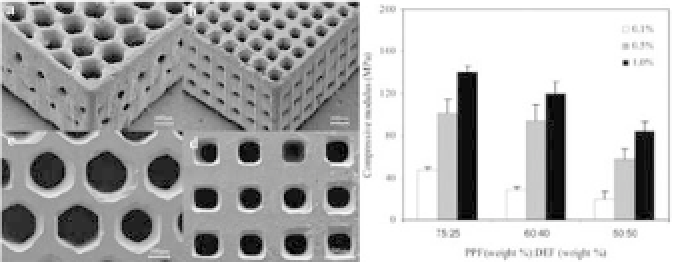Biomedical Engineering Reference
In-Depth Information
(a)
(b)
Figure 31.3.
(a) Fabricated scaffolds using PPF/DEF resin and (b) com-
pressive modulusof a cylindrical sample of PPF/DEFresin.
11
TMC, which can be cross-linked by ring-opening polymerization,
becomes a TMC-based photopolymer via combination with initia-
tors such as trimethylolpropane (TMP),
ε
-caprolactone (CL), or var-
ious molecular weights of polyethylene glycol (PEG). Kwon
et al
.
fabricated two-dimensional (2D) patterns and 3D structures with
TMC/TMP and TMC/PEG and observed the effects of the materials
on cell adhesion and proliferation (Fig. 31.4).
12
Further Lee
et al
.
fabricated a 3D scaffold with TMC/TMP using the MSTL system and
applied the scaffoldin cartilage regeneration (Fig. 31.5).
13
Schuster
et al
. developed an acrylate-based monomer formu-
lation consisting of a biodegradable-basis monomer derived from
gelation hydrolysate. These studies demonstrated that a 3D shape
could be fabricated using this material. In addition, they mixed
various reactive diluents such as urethanedimethacrylate (UDMA),
diisobutylacrylamide (DBA), dipentaerythritol pentaacrylate (PPA),
pentaerythritol triacrylate (PTA), trimethylolpropane triacrylate
Figure 31.4.
SEM image of (a) micropillar array, (b) microcorn array, and
(c) microbank array from TMC/PEG200.
12










Search WWH ::

Custom Search